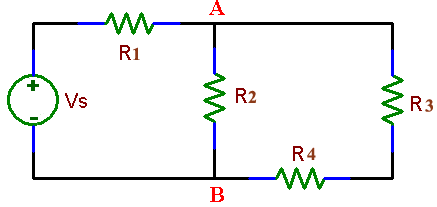|
ECE291 - LABORATORY II BASIC CIRCUIT LAWS; DC
OBJECTIVES Verifying experimentally Kirchoff’s laws and Ohm’s law in a series-parallel circuit. Establishing experimental error limits within which the laws can be verified with the instruments in the laboratory.
PRELAB
LABORATORY Equipment needed from the stockroom: ECE291 parts kit, a protoboard, a resistance substitution box, leads. Select four resistors in the 1k to 20k range from the parts kit, not using more than two resistors of the same nominal value. Nominal values can be determined from the color code (see Appendix A). Measure precisely each resistor with the digital meter at your bench. Using these resistors, assemble the circuit shown in Fig. 2 on a proto-board. Connect leads from the DC power supply to the terminals on the board and connect the terminals to the circuit with small wires by pushing their ends into the holes in the board. Set the voltage on the power supply to a few volts.
|
